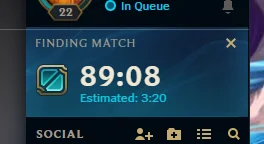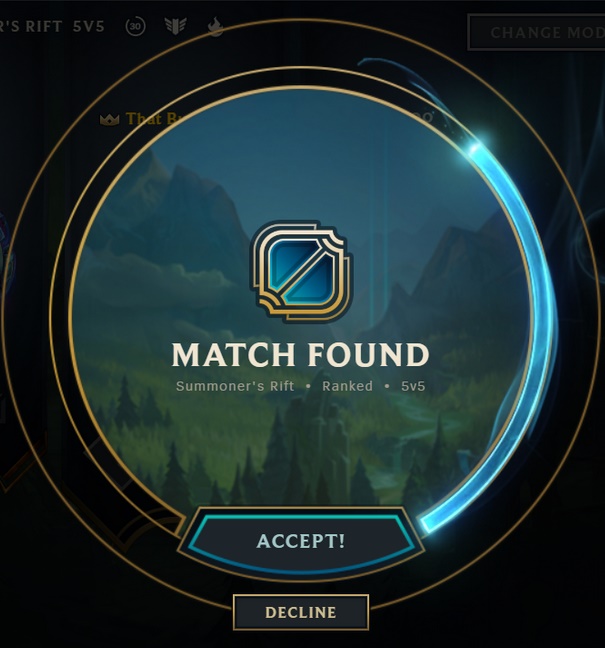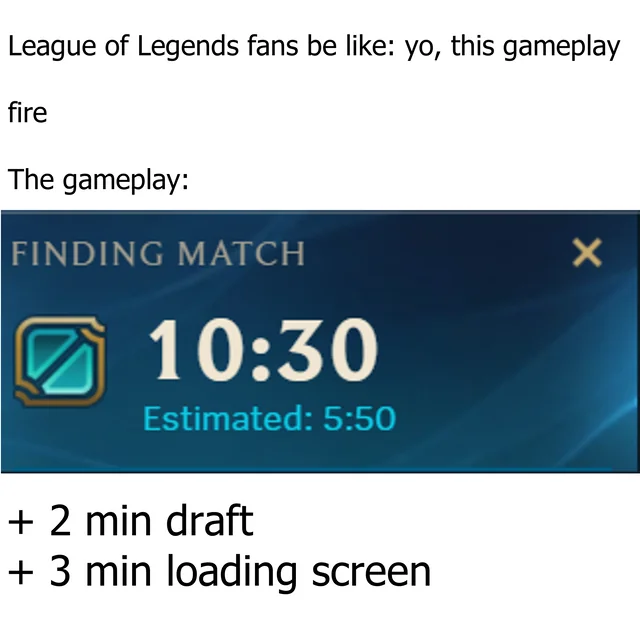Why Are League of Legends Queue Times So Long?
If you're here, you're probably looking at an incredibly long queue time for no good reason.
This article breaks down the real reasons queue times can be long, what's changed recently, and what you can do to spend less time waiting and more time playing.
However, in a quick summary, if you're jumpscared by an incredibly long queue, restart your client and check the Riot Service Status page. If you've already done this, then the next best thing to do is just... wait, really.

Matchmaking Mechanics
The system aims to match you with players of similar skill. But it also has to make sure every team has one top, one mid, a jungle, and two bot-laners (ADC and support). If everyone wants to play mid or top, it takes longer to build fair teams.
This is why role queue exists. For years before role queues, people would just enter the champion select chat and immediately typed what lane they wanted. If the chat was unsynched or somebody REALLY wanted to play their main role, then you'd be out of luck.
Differences Between Queues
Ranked Queue
Ranked queue often takes longer, especially:
- At high ranks like Master and Challenger (because there are fewer players at that level)
- During off-peak hours
- If you're queuing for a popular role like mid or ADC
In top tiers, it’s not rare to wait 10+ minutes for a match because the system has to find other high-skill players who want different roles.
Normal Queue
Normal games usually have shorter wait times, since the only constraining factors are roles and MMR. There's a wider pool of players that can be matched together, which makes the queue shorter.
Low Priority Queue
The low priority queue punishes bad behavior by making you wait longer on purpose—usually 5, 10, or even 20 minutes before you can rejoin matchmaking. However, after you wait out the mandatory timer, you'll still be thrown into the low priority queue.
It's unknown how forgiving the system is, but the implication is that, whenever the algorithm has to choose between queuing up a normal and low priority player into a role, it will always choose the normal player first. This can add 2-3 minutes to your queue times in low elo, or up to 15 minutes in higher elo.
Average League of Legends Queue Times in 2025
In 2025, queue times vary a lot depending on your region, rank, and role, but here’s a rough breakdown based on community data and reports:
- Unranked/Normal Games: ~1–3 minutes
- Low Ranked Solo Queue (Iron–Gold): ~2–4 minutes
- Mid to High Elo (Platinum–Diamond): ~4–10 minutes
- Master and above: 10+ minutes, sometimes 20+
Averages don’t tell the whole story. If you're queuing as a mid laner during off-peak hours, even a Gold player might face 5+ minute waits.
By this metric, we can expect Challenger midlaners to be stuck with the longest queue times in the game, ranging from 20-30 minutes if they want their main role.
However, if you're between Iron and Emerald (like ~60% of the playerbase), anything above 7 minutes should tip you off that something's wrong.
Queue Time by Time of Day and Server
If you're playing on a minor server (like LAN or OCE) at 3 a.m., you're going to wait. Even major servers like NA or EUW slow down late at night. Some new, low-population servers like ME may have incredibly long queue times even in peak hours. Check out our article on rank distributions if you want to know about the other effects caused by new, sparsely populated servers.
Bugs, Glitches, and Client Issues
Believe it or not, sometimes the client itself causes queue problems. Leaving your client open for hours, for example, can mess with matchmaking.
Some players report that keeping the client running nonstop leads to getting stuck in small matchmaking pools, especially in casual modes like ARAM. Restarting the client fixes it in many cases.

Why Your Queue Times Might Be Longer
There’s no single reason. It’s a mix of player behavior, system design, and technical changes. Here are the biggest culprits:
Role Popularity
Everyone wants to play mid, top or ADC. But each team only needs one of each. So if 80% of players are queuing for those roles, the system struggles to build balanced teams.
You might get autofilled, or just stuck waiting.
Player Pool Size
Some servers just have fewer people. Others lose players during off-peak hours. And in higher ranks, the pool shrinks even more.
Let’s say you’re a low Master player on NA. That means you’re in the top ~0.1% of players. Factor in smurfs, inactive accounts, and time zones—and there just aren’t many players at your level available at all times.
Matchmaking Algorithm Changes (Patch 13.21)
Patch 13.21 introduced tweaks to how the game forms matches. Riot tried to improve fairness by tightening skill match criteria and the maximum MMR difference between opponents, but it made matchmaking more complex.
High elo queues got hit the hardest with queue time increases of up to 2 minutes, but even casual players noticed that something felt off after the patch dropped. Specifically, duo queue restrictions have been tightened since, and duoing at high elo can produce some gnarly queue times.
Server Load & Bugs
When a patch goes live, more people log in. Lapsed players return, and everyone wants to test new changes. But that also means more stress on the servers, and more chances for bugs.
How to Avoid Low Priority Queues
If you’ve ever had to wait 20 minutes just to start queuing, you’ve likely been flagged for dodging or leaving games too often. Check out our dedicated article on Low Priority Queue if you want to learn more.
Tips to Reduce Wait Time in LoL Matches
You can’t control Riot’s matchmaking algorithm, but there are some choices you can make to help you get into games faster.

Be Flexible with Roles
If you always queue for mid or ADC, expect longer waits. However, you'll see your queue times skyrocket if you add jungle or support to your role roster. Put priority roles as your primary or secondary pick and you’ll see your queue times cut by at least a minute.
Play at Peak Times
Queueing during peak hours means more players online—so more match options. Try to play:
- Evenings (5–10 p.m.) local time
- Weekends, especially Saturdays
Avoid queuing during early mornings or late-night hours unless you’re on a high-population server.
If you’re stuck waiting 20+ minutes in Master-tier solo queue, consider playing on a low-elo smurf to stay sharp while avoiding long delays. Many players use alts to warm up or test new champs between ranked grinds.
FAQs
Here are some of the top questions players search—and real, direct answers to each.
1. How long are League of Legends queue times?
It depends on your rank, role, and region. On average:
- Unranked/Normal Games: ~1–3 minutes
- Low Ranked Solo Queue (Iron–Gold): ~2–4 minutes
- Mid to High Elo (Platinum–Diamond): ~4–10 minutes
- Master and above: 10+ minutes, sometimes 20+
2. What is a Low Priority Queue in League of Legends?
It’s a penalty queue that adds a delay (5–20 minutes) before you can even start searching for a match, before putting you in a queue that prioritizes non-penalized players over penalized ones. It usually happens if you dodge games or leave matches too often.
Check out our dedicated article on low priority queue for more information.
3. Why are League Queues so Long Right Now?
Patch 13.21, which made the matchmaking algorithm less forgiving on large differences in MMR, made queue times a little longer. However, this increase should be minimal for most players. If you're experiencing very long queue times, check out the Riot Games Server Status page.
4. How Do I Get Out of Low Priority Queue?
You can’t skip it. You have to serve the time by completing a certain number of full games.
5. Does Role Selection Impact Wait Time?
Yes, a lot. The more popular the role (like mid or bot), the longer the queue. Choosing support or fill usually gets you into games faster.





